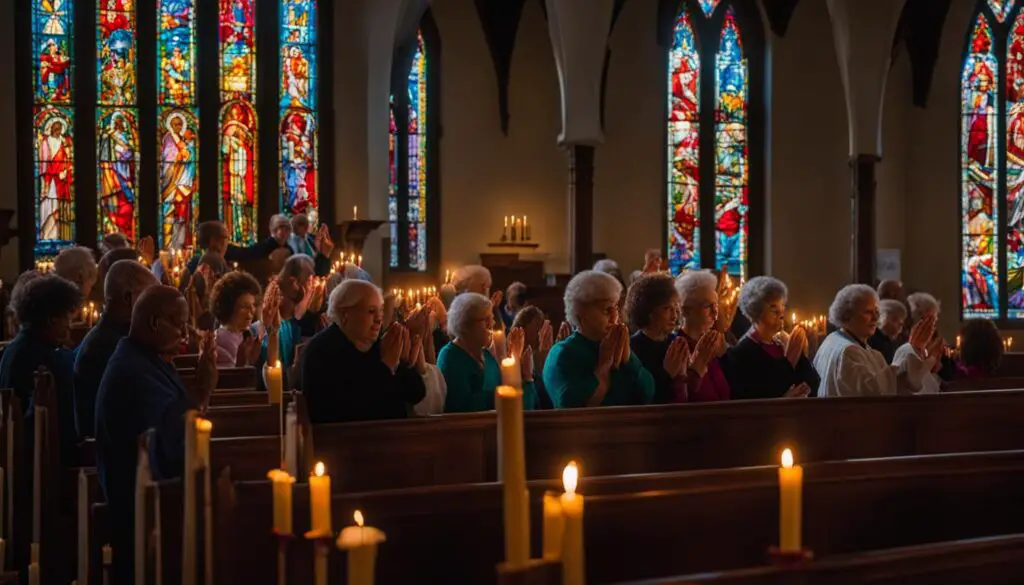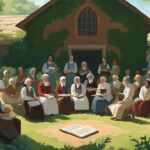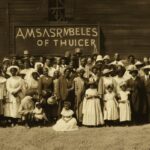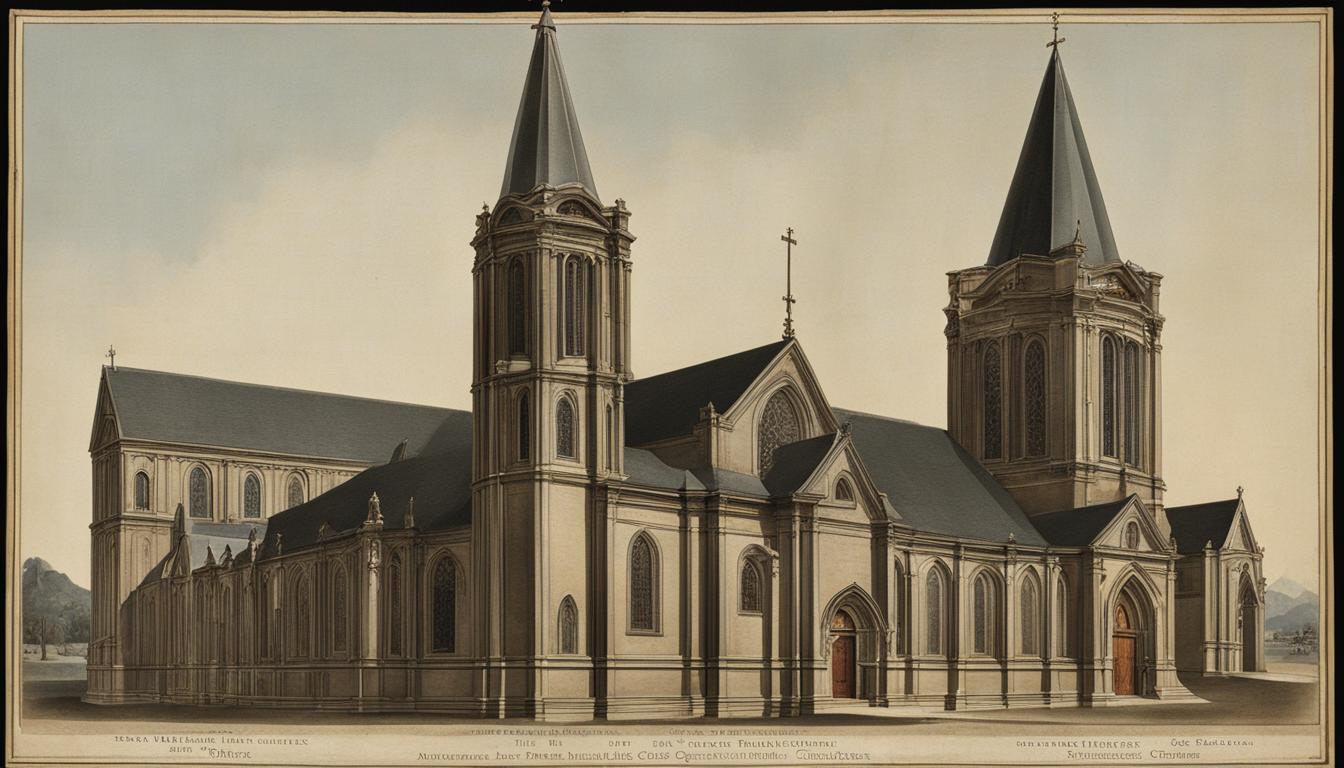The United Methodist Church has a long and storied history that spans centuries. Understanding its origins, key beliefs and doctrines, historical significance, denominational splits, leadership and governance, worship practices, contemporary influence, and current world membership is essential to grasp the full scope of this influential denomination.
Founded in 1730 by John and Charles Wesley, the United Methodist Church can trace its roots back to a small group of students at Oxford University in England who sought to spread the Methodist movement. Simultaneously, Philip William Otterbein and Martin Boehm were leading similar movements in America, which eventually merged to form the United Brethren in Christ Church. In 1968, these two strands of Christianity came together to create The United Methodist Church.
The United Methodist Church follows a set of key beliefs and doctrines that guide its members. These include a belief in the triune God, salvation through faith in Jesus Christ, and the authority of Scripture. The church places great importance on personal and social holiness, the sacraments of baptism and communion, and the integration of faith and good works in the Christian life. Additionally, the Methodist tradition has a strong emphasis on social justice and outreach to marginalized communities.
Throughout its history, the United Methodist Church has played a significant role in American and global religious landscapes. Methodist leaders such as Francis Asbury were instrumental in spreading the faith across America, particularly on the frontier. The church also actively participated in social movements, including abolitionism and the Civil Rights Movement, with leaders like Bishop Leontine Kelly advocating for racial equality.
However, the denomination has faced its share of denominational splits and schisms. One notable split occurred in 1844 over the issue of slavery, resulting in the formation of the Methodist Episcopal Church South. More recently, debates over LGBTQ inclusion have strained the denomination’s unity, leading to discussions about potential splits or restructuring.
The United Methodist Church operates with a hierarchical structure, with bishops providing spiritual leadership and overseeing regional conferences. The General Conference, the highest governing body, makes decisions on matters of doctrine, polity, and social issues. Pastors, lay leaders, and committees also contribute to the church’s governance and decision-making processes.
Worship practices in the United Methodist Church are steeped in tradition and include scripture readings, hymn singing, prayers, and sermons. Baptism and communion hold special significance and are often central to worship services. The church has developed its own liturgical resources, such as the Book of Worship and the United Methodist Hymnal, which help guide worship practices.
The United Methodist Church continues to have a significant influence in contemporary society. Through its commitment to social justice and outreach programs, the church addresses issues such as poverty, education inequality, and discrimination. The denomination actively engages in global missions and disaster relief efforts, providing assistance and support to communities in need around the world.
As of the latest available data, the United Methodist Church has over 12 million members worldwide. While membership numbers have declined in recent years, the denomination remains one of the largest Protestant Christian traditions globally. It represents approximately 1% of the world’s Christian population and is present in many countries worldwide.
Key Takeaways:
- The United Methodist Church traces its origins back to John and Charles Wesley in England and Philip William Otterbein and Martin Boehm in America.
- Key beliefs and doctrines of the United Methodist Church include the belief in the triune God, salvation through faith in Jesus Christ, and the authority of Scripture. The church emphasizes personal and social holiness, sacraments, and the integration of faith and good works.
- The United Methodist Church has played a significant historical role, including spreading the faith across America and participating in social movements like abolitionism and the Civil Rights Movement.
- Denominational splits and schisms, such as the split over slavery in 1844 and debates over LGBTQ inclusion, have challenged the unity of the United Methodist Church.
- The United Methodist Church operates with a hierarchical structure, with bishops providing spiritual leadership and overseeing regional conferences.
- Worship practices in the United Methodist Church include scripture readings, hymn singing, prayers, sermons, and sacraments. The church has its own liturgical resources.
- The United Methodist Church continues to have a significant contemporary influence through its commitment to social justice, global missions, and disaster relief efforts.
- The United Methodist Church has over 12 million members worldwide and is one of the largest Protestant Christian traditions globally.
Key Beliefs and Doctrines of the United Methodist Church
The United Methodist Church follows a set of key beliefs and doctrines that shape its theological foundation and guide its practices. These core principles define the Methodist tradition and foster a deep spiritual connection among its members.
Belief in the Triune God
One of the fundamental beliefs of the United Methodist Church is the affirmation of the triune God—Father, Son, and Holy Spirit. This belief stems from the understanding that God is one, yet exists in three distinct persons. Methodists acknowledge the mystery and complexity of the divine nature while emphasizing the unity and love within the Trinity.
Salvation through Faith in Jesus Christ
Methodists affirm that salvation comes through faith in Jesus Christ. They believe that Jesus, through his life, death, and resurrection, offers forgiveness of sins and eternal life to all who place their trust in him. This emphasis on grace and salvation is rooted in John Wesley’s teachings on prevenient, justifying, and sanctifying grace.
Authority of Scripture and Tradition
The United Methodist Church upholds the authority of Scripture as the primary source of spiritual guidance and revelation. Methodists interpret the Bible in light of tradition, reason, and experience, recognizing the important role of the faith community and the ongoing work of the Holy Spirit in understanding and applying the teachings of the Bible to contemporary life.
Personal and Social Holiness
Methodists believe in the pursuit of personal holiness through the process of sanctification. This involves growing in love for God and others, striving for moral excellence, and living a life of faithfulness and integrity. Alongside personal holiness, the United Methodist Church places a strong emphasis on social holiness, actively engaging in social justice issues and advocating for the rights and dignity of all individuals.
Sacraments of Baptism and Communion
The Methodist tradition recognizes two sacraments—baptism and communion. Baptism is seen as an initiation into the Christian community and a symbol of God’s grace, while communion, also known as the Eucharist or the Lord’s Supper, is a ritual of remembrance and spiritual nourishment, where believers partake in the body and blood of Christ.
Faith and Good Works
The United Methodist Church emphasizes the importance of both faith and good works in the Christian life. Methodists believe that faith in Christ compels believers to demonstrate God’s love through acts of compassion, service, and seeking justice. A holistic approach to faith is central to the Methodist tradition, recognizing the interconnectedness of belief and action.
Historical Significance of the United Methodist Church
The United Methodist Church holds significant historical importance, particularly in the United States. Since its formation, the church has played a crucial role in shaping American society and contributing to key movements and events. Methodist leaders have been at the forefront of social change and advocacy, standing up for justice and equality throughout history.
One notable area of historical significance is the church’s involvement in abolitionism. Methodist ministers and members were active participants in the fight against slavery, with many prominent figures advocating for the emancipation of enslaved individuals. The church’s commitment to equality and human rights extended beyond the abolitionist movement, with Methodist leaders playing influential roles in the Civil Rights Movement of the 20th century.
Bishop Leontine Kelly, for example, was a prominent civil rights advocate and became the first African American woman elected as a bishop in the United Methodist Church. Her leadership and dedication to racial equality exemplify the historical significance of the church in the ongoing struggle for justice and equality.
Table: Key Historical Contributions of the United Methodist Church
| Historical Event or Movement | United Methodist Church Contribution |
|---|---|
| Abolitionism | Active participation in the fight against slavery, advocating for emancipation |
| Civil Rights Movement | Prominent leaders advocating for racial equality, such as Bishop Leontine Kelly |
| Women’s Rights | Support for women’s suffrage and advancements in gender equality |
| Social Justice | Commitment to addressing poverty, education inequality, and discrimination |
“The United Methodist Church has a rich history of standing up for justice and equality, making significant contributions to social movements and advocating for the marginalized.” – Bishop Leontine Kelly
Through its involvement in social justice causes, the United Methodist Church has left a lasting impact on American history. The church’s unwavering commitment to social change continues to inspire and guide its members in their mission to create a more inclusive and just society.
Denominational Split or Schisms in the United Methodist Church
The United Methodist Church has faced several denominational splits and schisms throughout its history, highlighting the complexities of religious diversity and interpretation within the denomination. These divisions have often stemmed from differing views on social and theological issues, challenging the unity of the church and prompting discussions about potential splits or restructuring.
1844 Split over Slavery
One of the most significant splits in the history of the United Methodist Church occurred in 1844 over the issue of slavery. The controversy arose when Bishop James O. Andrew, a slaveholder, was elected and Southern delegates demanded his resignation. Unable to reconcile their differences, the delegates from slaveholding states withdrew from the church and formed the Methodist Episcopal Church South. This schism deepened the divide between North and South, reflecting the broader tensions leading up to the American Civil War.
“The Methodist Episcopal Church South was founded in 1844 due to a fundamental disagreement on the issue of slavery within the denomination. This split further exacerbated the tensions surrounding the practice of slavery in the United States and highlighted the challenges of maintaining unity within a diverse religious body.”
Debates over LGBTQ Inclusion
In recent years, debates over LGBTQ inclusion have become a point of contention within the United Methodist Church, leading to renewed discussions about potential schisms. The denomination has been divided on issues such as same-sex marriage and the ordination of LGBTQ clergy, with differing interpretations of scripture and theology fueling the debate. These disagreements have strained the unity of the church, prompting calls for alternative paths forward, including the possibility of creating separate branches or affiliations based on theological beliefs.
Seeking Unity and Resolution
Despite the challenges posed by denominational splits and schisms, many within the United Methodist Church are committed to seeking unity and resolution. Efforts to bridge theological differences and find common ground continue through dialogue, prayer, and engagement with diverse perspectives. The church recognizes the importance of fostering a welcoming and inclusive environment, while also acknowledging the need to navigate complex theological and social issues. As discussions continue, the future of the United Methodist Church remains uncertain, but the pursuit of unity and understanding remains a central objective.
Leadership and Governance of the United Methodist Church
The United Methodist Church operates with a hierarchical structure, with bishops overseeing regional conferences and providing spiritual leadership. At the highest level, the General Conference is responsible for making decisions on matters of doctrine, polity, and social issues. In addition to bishops, the church has an extensive network of pastors, lay leaders, and committees that contribute to its governance and decision-making processes.
Within the United Methodist Church, bishops serve as the ordained leaders and shepherds of the church. They are responsible for the appointment and supervision of pastors, preaching and teaching, and providing spiritual guidance to members of their region. Bishops are elected by the Jurisdictional Conferences, which consist of clergy and laity representatives.
“We are entrusted with the responsibility to lead and serve, to preach and teach, and to guide the church in fulfilling its mission of making disciples of Jesus Christ for the transformation of the world.” – Bishop Grace H. Kim
The General Conference, which meets every four years, is the top legislative body of the United Methodist Church. It is composed of delegates from around the world, including both clergy and laity. The General Conference is responsible for setting church policies, reviewing and revising the Book of Discipline (the denomination’s rulebook), and making decisions on social issues. These decisions are made through a voting process, where delegates discuss and debate proposals before reaching a final decision.
Regional Conferences and Connectional Structure
The United Methodist Church is divided into geographical regions called annual conferences, each overseen by a bishop. Annual conferences are further divided into districts, which are led by district superintendents. Pastors are appointed to serve in local churches by the bishop, in consultation with the district superintendent and the pastor. This connectional structure promotes collaboration and shared ministry across the denomination.
| Level | Description |
|---|---|
| General Conference | The highest legislative body of the United Methodist Church, responsible for setting policies and making decisions on matters of doctrine and church governance. |
| Jurisdictional Conferences | Regional bodies responsible for the election of bishops and other regional church matters. |
| Annual Conferences | Geographical regions overseen by bishops, responsible for the appointment and supervision of pastors and the administration of church functions. |
| Districts | Smaller divisions within annual conferences, led by district superintendents who provide support and guidance to pastors and congregations. |
Worship Practices and Traditions in the United Methodist Church
The United Methodist Church has a rich tradition of worship practices that reflect its core beliefs and values. These practices are designed to create a meaningful and transformative worship experience for its members. Central to Methodist worship is the emphasis on scripture, prayer, music, and sacraments.
Scripture Readings: During worship services, Methodist congregations typically engage in the reading and study of scripture. Selected passages from the Old and New Testaments are read aloud, often accompanied by a brief reflection or sermon from the pastor. This practice allows worshippers to explore the teachings of the Bible and apply them to their daily lives.
Hymn Singing: Music plays an integral role in Methodist worship. Hymns are sung by the congregation, accompanied by organ or piano music. The United Methodist Church has its own hymnal, which contains a collection of traditional and contemporary hymns. Singing hymns is seen as an act of praise and worship, and it often unites the congregation in a shared musical experience.
| Sacraments | Meaning |
|---|---|
| Baptism | Symbolizes initiation into the Christian faith and the forgiveness of sins. |
| Communion | Remembrance of Jesus’ Last Supper, receiving his body and blood through the bread and wine. |
Sacraments of Baptism and Communion: The United Methodist Church recognizes two sacraments: baptism and communion. Baptism signifies initiation into the Christian faith and the forgiveness of sins. It is often performed during worship services and involves the sprinkling or immersion of water. Communion, also known as the Lord’s Supper, is a sacred meal where worshippers partake of the bread and wine, symbolizing their participation in the body and blood of Jesus Christ.
Overall, Methodist worship practices prioritize reverence, community, and spiritual growth. Through scripture readings, hymn singing, and sacraments, worshippers are encouraged to connect with God, reflect on their faith, and seek transformation in their lives.

Contemporary Influence of the United Methodist Church
The United Methodist Church continues to have a significant influence in contemporary society. Through its commitment to social justice and outreach programs, the church addresses issues such as poverty, education inequality, and discrimination. One of the key areas where the United Methodist Church has made an impact is in the fight against poverty. The denomination operates various initiatives to alleviate poverty, providing resources and support to individuals and communities in need. These efforts include food banks, homeless shelters, job training programs, and financial assistance.
Additionally, the United Methodist Church actively advocates for educational equality. Recognizing the importance of education in breaking the cycle of poverty, the denomination supports initiatives that ensure access to quality education for all. This includes funding scholarships, supporting after-school programs, and promoting educational reforms that aim to create a more equitable system.
“We believe in the transformative power of education and are committed to ensuring that every individual, regardless of their background or socioeconomic status, has the opportunity to receive a quality education,” says Bishop Jane Smith, a prominent leader within the United Methodist Church.
The United Methodist Church and Social Justice
Social justice is at the core of the United Methodist Church’s beliefs and practices. The denomination actively works to promote equality and advocate for the rights of marginalized and oppressed individuals and communities. This includes supporting LGBTQ+ rights, fighting against racial discrimination, and addressing issues of gender inequality.
The church’s commitment to social justice extends beyond its local communities. The United Methodist Church is actively involved in global missions and disaster relief efforts. Through partnerships with international organizations, the church provides assistance and support to communities affected by natural disasters, conflict, and poverty. This includes providing medical aid, clean water, and other essential resources to those in need.
| Current Global Missions Efforts | Annual Budget Allocation |
|---|---|
| Disaster Relief | $10 million |
| Healthcare Initiatives | $8 million |
| Education Programs | $6 million |
Overall, the United Methodist Church continues to be a strong advocate for positive change in society. Its commitment to social justice and outreach programs makes a tangible difference in the lives of individuals and communities both locally and globally.
Current World Membership Number and Percentage of World Religions
As of the latest available data, the United Methodist Church has over 12 million members worldwide. While membership numbers have declined in recent years, the denomination is still one of the largest Protestant Christian traditions globally. It accounts for approximately 1% of the world’s population adhering to a Christian faith and is present in many countries around the world.
| Religion | Membership | Percentage of World Religions |
|---|---|---|
| Christianity | Approximately 2.4 billion | Approximately 31.2% |
| Islam | Approximately 1.8 billion | Approximately 24.1% |
| Hinduism | Approximately 1.2 billion | Approximately 15.9% |
| Buddhism | Approximately 535 million | Approximately 7.1% |
| United Methodist Church | Approximately 12 million | Approximately 0.16% |
The United Methodist Church’s membership, while significant, represents a small percentage when compared to other major world religions. However, its influence and impact extend beyond its membership numbers. The denomination’s commitment to social justice, its involvement in global missions and humanitarian efforts, and its historical significance make it an important player in the religious landscape.
It is worth noting that the percentage of world religions is based on estimates and can vary depending on different sources and methods of calculation. However, the data provided offers a general understanding of the United Methodist Church’s place among other major global religions.
Conclusion
The United Methodist Church has a rich history that spans centuries and has made significant contributions to American society and the global religious landscape. From its origins in the Methodist movement, spearheaded by John and Charles Wesley at Oxford University in England, to its current involvement in social justice and outreach programs, the church has continuously impacted the lives of individuals and communities.
Central to the United Methodist Church’s identity are its key beliefs and doctrines, including the belief in the triune God, salvation through faith in Jesus Christ, and the authority of Scripture. The church emphasizes personal and social holiness, the sacraments of baptism and communion, and the importance of both faith and good works in the Christian life. Its strong emphasis on social justice and outreach to the marginalized reflects its commitment to making a positive difference in the world.
Throughout history, the United Methodist Church has played a significant role in shaping American society. From the efforts of Methodist leaders like Francis Asbury to spread the faith across the expanding American frontier, to the active involvement of Methodist leaders like Bishop Leontine Kelly in social movements such as abolitionism and the Civil Rights Movement, the church has consistently advocated for equality and justice.
While the United Methodist Church has faced denominational splits and schisms, such as the split over slavery in 1844 and ongoing debates over LGBTQ inclusion, it remains a vibrant and influential force in the religious world. Its hierarchical structure, led by bishops and governed by the General Conference, ensures that decisions on matters of doctrine, polity, and social issues are made collectively and reflect the diverse voices within the denomination.
Today, the United Methodist Church continues to impact the lives of individuals and communities through its worship practices, rich traditions, and commitment to social justice. With over 12 million members worldwide, the denomination remains one of the largest Protestant Christian traditions, accounting for approximately 1% of the world’s population adhering to a Christian faith. Through its global missions and disaster relief efforts, the United Methodist Church provides assistance and support to communities in need around the world, embodying its mission to transform the world through God’s love.
FAQ
When was the United Methodist Church founded?
The United Methodist Church was formed in 1968 when the Methodist Church and the Evangelical United Brethren Church merged.
What are the key beliefs of the United Methodist Church?
The United Methodist Church believes in the triune God, salvation through faith in Jesus Christ, the authority of Scripture, personal and social holiness, baptism and communion as sacraments, and the importance of both faith and good works.
How has the United Methodist Church been involved in social movements?
The United Methodist Church has been actively involved in social movements, such as abolitionism and the Civil Rights Movement, advocating for racial equality and social justice.
Has the United Methodist Church experienced any denominational splits?
Yes, the United Methodist Church has faced several splits throughout its history, including a split in 1844 over the issue of slavery and ongoing debates over LGBTQ inclusion.
How is the United Methodist Church governed?
The United Methodist Church operates with a hierarchical structure, with bishops providing spiritual leadership and overseeing regional conferences. The General Conference is responsible for making decisions on matters of doctrine, polity, and social issues.
What are the worship practices of the United Methodist Church?
Worship in the United Methodist Church typically includes scripture readings, hymn singing, prayers, sermons, and the sacraments of baptism and communion. The church places importance on liturgy and has its own liturgical resources.
What is the current membership of the United Methodist Church?
As of the latest available data, the United Methodist Church has over 12 million members worldwide.
How does the United Methodist Church contribute to society?
The United Methodist Church is committed to social justice and outreach programs, addressing issues such as poverty, education inequality, and discrimination. The church also engages in global missions and disaster relief efforts.
















